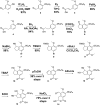Cocaine reward is reduced by decreased expression of receptor-type protein tyrosine phosphatase D (PTPRD) and by a novel PTPRD antagonist
- PMID: 30348770
- PMCID: PMC6233130
- DOI: 10.1073/pnas.1720446115
Cocaine reward is reduced by decreased expression of receptor-type protein tyrosine phosphatase D (PTPRD) and by a novel PTPRD antagonist
Abstract
Receptor-type protein tyrosine phosphatase D (PTPRD) is a neuronal cell-adhesion molecule/synaptic specifier that has been implicated in addiction vulnerability and stimulant reward by human genomewide association and mouse cocaine-conditioned place-preference data. However, there have been no reports of effects of reduced expression on cocaine self-administration. There have been no reports of PTPRD targeting by any small molecule. There are no data about behavioral effects of any PTPRD ligand. We now report (i) robust effects of heterozygous PTPRD KO on cocaine self-administration (These data substantially extend prior conditioned place-preference data and add to the rationale for PTPRD as a target for addiction therapeutics.); (ii) identification of 7-butoxy illudalic acid analog (7-BIA) as a small molecule that targets PTPRD and inhibits its phosphatase with some specificity; (iii) lack of toxicity when 7-BIA is administered to mice acutely or with repeated dosing; (iv) reduced cocaine-conditioned place preference when 7-BIA is administered before conditioning sessions; and (v) reductions in well-established cocaine self-administration when 7-BIA is administered before a session (in WT, not PTPRD heterozygous KOs). These results add to support for PTPRD as a target for medications to combat cocaine use disorders. 7-BIA provides a lead compound for addiction therapeutics.
Keywords: Post-GWAS; addiction; cell adhesion molecule; drug discovery; stimulant use disorder.
Conflict of interest statement
The authors declare no conflict of interest.
Figures




References
-
- Substance Abuse and Mental Health Services Administration 2016. SAMHSA Results from the 2015 Survey of Drug Use in Households (Center for Behavioral Health Statistics and Quality, Rockville, MD)
-
- Uhl GR, et al. Genome-wide association for methamphetamine dependence: Convergent results from 2 samples. Arch Gen Psychiatry. 2008;65:345–355. - PubMed
Publication types
MeSH terms
Substances
LinkOut - more resources
Full Text Sources
Other Literature Sources
Medical
Molecular Biology Databases
Research Materials

